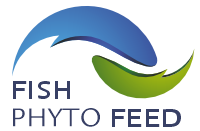Introduction
The aquaculture sector has experienced rapid development, providing economic benefits to countries utilizing the industry. However, continuous growth and reduced wild fish stocks have led to reduced availability and increased prices of fishmeal and fish oil for fish feeds. Alternative protein sources of low ecological footprint and at affordable prices for fish feed formulation are key to the sustainable development of aquaculture. Nevertheless, they often impact fish physiology and metabolism due to the presence of various endogenous antinutritional factors and phytoestrogens (1). The deposition of proteins in the white muscle, which is the largest and continuously increasing tissue in fish and constitutes 58-80% of their total body weight, is the ultimate goal in fish farming. The growth of fish is affected by phytoestrogens and antinutritional factors, whose effects vary depending on their concentration, fish species, and other factors. Phytoestrogens may compromise growth and disrupt reproductive function, while antinutritional factors can reduce growth and cause health issues. The demonstrated negative effect of phytoestrogens on white muscle development and growth highlights the need for tools to screen for potential myostatic action of raw materials and fish feeds (2). This study combines different approaches to validate white muscle gene markers (3) in the gilthead seabream, Sparus aurata L., as indicators of compromised myogenesis when fed alternative protein sources.
Materials and methods
Three diets were formulated – a soy-free diet (C), a 20% soybean meal diet (SBM), and a 20% soy protein concentrate diet (SPC) – and they were fed to triplicate groups of gilthead seabream of 27g average initial BW for two months. After the three-month period, sampling was conducted in all three groups and samples were stored in RNAlater at -20oC until RNA extraction. In a second approach, extracts of the diets and of raw materials were applied in primary cultures of myogenic progenitor cells from seabream for three different exposure times and four different quantities of the food extract (0, 2, 4 mg) following the onset of differentiation. Cells were collected at the end of the exposure and RNA was isolated. The expression levels of mylpfa (myosin light chain phosphorylatable, fast skeletal muscle a, associated with hypertrophy), mylpfb (associated with hyperplasia), and myog (myogenin) in white muscle were determined at the end of the experiment using real time RT-PCR. The results were analysed using the R programming language.
In teleosts, muscle growth occurs through two main mechanisms: hyperplasia, which involves the recruitment of new muscle fibers, and hypertrophy, which involves an increase in the size of existing muscle fibers. The effects of SBM and SPC on hyperplasia and hypertrophy in the feeding trial were consistent with the effects recorded in vitro. Hyperplasia as marked by mylpfb expression was significantly reduced in fish fed on SBM and SPC, whereas hypertrophy as marked by mylpfa expression was significantly reduced only in fish fed on SBM. Myogenin (myog) expression remained unaffected.
Similar results were recorded in primary cell cultures after 48h of exposure to diet extracts; both SBM and SPC were potent in downregulating mylpfb expression, whereas mylpfa expression was significantly affected only in the presence of SBM extract. Increasing the extract quantity in the SBM and SPC diets resulted in reduced expression levels for mylpfa. In contrast, mylpfb expression was not greatly affected by increasing extract quantity in SBM and SPC.
Myogenin expression remained largely unaffected by the presence of the raw materials extracts in the primary culture. However, there are noteworthy findings: mylpfb expression significantly increased in the presence of corn gluten extract, and mylpfa expression was elevated in the presence of either corn gluten or wheat gluten extract, suggesting their potential influence on muscle growth.
To our knowledge this is the first study to demonstrate that primary cultures of myogenic progenitor cells can be used as a screening tool for potential myostatic action of raw materials and fish feeds containing alternative protein sources.
Conclusions
Our results offer new insights into the mechanisms behind myostatic action of plant raw materials rich in phytoestrogens. Differences recorded in fish growth in vivo could be attributed to differentiated white muscle hyperplasia and hypertrophy with the help of molecular markers. The validation of the myostatic action of raw materials and fish feeds in vitro comes with an added value as a tool for wide-scale screening in search for sustainable raw materials for fish feeds.



